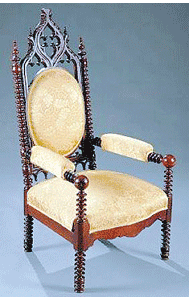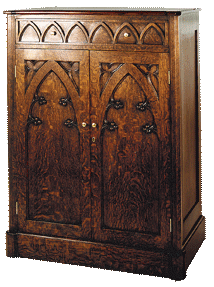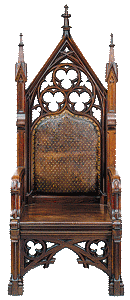- Prelude
- Guest Editor’s Column
- Hard Talk
- Eloquence of Silence
- The Age of Revivals: Gothic Revival Furniture
- Inkwell
- New Media : Living up to the chivalric code
- Universalizing Art through Individual Langue
- Speaking New Discourses
- Video Art of India- Gigi Scaria and his Videos
- Contemporary Trends of Sculpting
- In the News
- Artist Index and Statistics
- Market Insight
- Auction Reports
- The month that was
- Art Bengaluru
- Mumbai Artsighting
- Musings from Chennai
- Deccan Odyssey
- Delhi Dias
- In between – from Vadodara
- North-East Opsis
- A Tryst with Art in Madhya Pradesh
- Tradition and Beyond
- Reverie
- Indian (Sub) Way
- Creative Impulse
- Different hues of Aakriti
ART news & views
The Age of Revivals: Gothic Revival Furniture
Volume: 2 Issue No: 8 Month: 9 Year: 2010
 Between 1840 and 1900, Victorian designers started looking up to older classical styles for design inspirations, this evolved the revival of earlier styles and almost half a dozen older styles were revived in the newer sense. These revival styles are broadly put into two categories, The Classical Revival and the Gothic revival. The Gothic revival is the revival of the Gothic style which was popular in the 12th century. The gothic revival also known as Victorian Gothic or Neo-Gothic is an architectural movement which began England. Its popularity grew rapidly in the early nineteenth century, when increasingly serious and learned admirers of Neo-Gothic styles sought to revive medieval forms, in contrast to the neoclassical styles prevalent at the time. England was the centre of the revival as the renewed interest started in the Church and Christianity.
Between 1840 and 1900, Victorian designers started looking up to older classical styles for design inspirations, this evolved the revival of earlier styles and almost half a dozen older styles were revived in the newer sense. These revival styles are broadly put into two categories, The Classical Revival and the Gothic revival. The Gothic revival is the revival of the Gothic style which was popular in the 12th century. The gothic revival also known as Victorian Gothic or Neo-Gothic is an architectural movement which began England. Its popularity grew rapidly in the early nineteenth century, when increasingly serious and learned admirers of Neo-Gothic styles sought to revive medieval forms, in contrast to the neoclassical styles prevalent at the time. England was the centre of the revival as the renewed interest started in the Church and Christianity.  The Gothic revival style was influenced from medieval Gothic architecture. Early in the period, Gothic Revival houses were constructed of stone and brick imitating the castles and magnificent cathedrals of Europe. With the desire for quick construction and the affordable availability of lumber in the United States, wooden cottages and villas in the Gothic Revival style became popular. Sometimes Gothic Revival Cottages are referred to as Carpenter Gothic. With the invention of steam-powered saw mills and new saws, Carpenter Gothic styles were heavily decorated with lacey "gingerbread" trim and scrolled ornaments. Identifying features of Gothic Revival are steeply pitched roofs, usually with steep cross gables; intricately carved verge boards (barge boards) along the eaves and gable edges (beyond the mid-1860's, intricate verge boards were replaced by decorative cross bracing at the uppermost point of the gable); vertical board-and-batten siding in gray and earthy tones; tall diamond-paned windows most often placed in gables, having pointed arches or two or three arches grouped together; arched or square hood moldings (drip-molding) over windows.
The Gothic revival style was influenced from medieval Gothic architecture. Early in the period, Gothic Revival houses were constructed of stone and brick imitating the castles and magnificent cathedrals of Europe. With the desire for quick construction and the affordable availability of lumber in the United States, wooden cottages and villas in the Gothic Revival style became popular. Sometimes Gothic Revival Cottages are referred to as Carpenter Gothic. With the invention of steam-powered saw mills and new saws, Carpenter Gothic styles were heavily decorated with lacey "gingerbread" trim and scrolled ornaments. Identifying features of Gothic Revival are steeply pitched roofs, usually with steep cross gables; intricately carved verge boards (barge boards) along the eaves and gable edges (beyond the mid-1860's, intricate verge boards were replaced by decorative cross bracing at the uppermost point of the gable); vertical board-and-batten siding in gray and earthy tones; tall diamond-paned windows most often placed in gables, having pointed arches or two or three arches grouped together; arched or square hood moldings (drip-molding) over windows. Gothic revival furniture is based on the Gothic style of architecture. In 19th century England and the United States many furniture pieces were created to complement it. Design elements used in Gothic revival furniture include trefoil and quatrefoil shapes, pointed arches and gargoyles. These are expressed using heavy, intricate carvings on tables, chairs and beds. Heavy wood finished in a dark stain, such as rosewood, oak and walnut are used to construct Gothic revival furniture. Upholstery choices are generally heavy fabrics, such as velvet, brocade or leather. Gothic revival furniture ranges in type from expensive antiques from the 19th century to inexpensive modern reproduction pieces. Gothic furniture is a distinct and powerful design statement. It often carries a religious connotation because Gothic architecture is associated with church design.
Gothic revival furniture is based on the Gothic style of architecture. In 19th century England and the United States many furniture pieces were created to complement it. Design elements used in Gothic revival furniture include trefoil and quatrefoil shapes, pointed arches and gargoyles. These are expressed using heavy, intricate carvings on tables, chairs and beds. Heavy wood finished in a dark stain, such as rosewood, oak and walnut are used to construct Gothic revival furniture. Upholstery choices are generally heavy fabrics, such as velvet, brocade or leather. Gothic revival furniture ranges in type from expensive antiques from the 19th century to inexpensive modern reproduction pieces. Gothic furniture is a distinct and powerful design statement. It often carries a religious connotation because Gothic architecture is associated with church design. 
The Gothic furniture in America was an adaptation of Gothic architectural form and ornament. Designs for this type of furniture were first published in England by Thomas Chippendale in his Gentlemen and Cabinet Maker's Directory in 1754. The designs show straight legs, tracery, and chair splats that form pointed arches. The style was encouraged by Andrew Jackson Downing's home in Newburgh, New York, and by his two books, Cottage Residences, and Architec-ture of Country Homes. Most of the pieces were made of walnut. While this style was not overwhelmingly popular in this country, between 1830 and 1840 it was used by architects and well known cabinetmakers. The Furniture Designers who were popular in the 19th century included Alexander Jackson Davis, Thomas Chippendale and Augustus Pugin.
 Furniture designs were directly influenced by the Gothic architecture of the past with ornate carving and a heavily favored foliage motif for ornamentation. The foliage motif that was characteristic of Gothic furniture varied from uncomplicated to extremely detailed designs. Some of the more notable features of Gothic-style furniture include the renowned pointed arches, gargoyles, rosettes, real and imaginary animals and misshapen figures. The bell flower, a floral motif with three or four lobes and a bell in the hollow center, was another common Gothic ornamentation. In addition, Gothic furniture can be identified by the use of the popular Gothic trefoil (three-lobed shape), quatrefoil (flower design with four petals), and cinquefoil (five arcs). Tracery was the ornamental stonework that could be found supporting the glass in the head of windows in Gothic architecture. The stonework was formed into a pattern often times with trefoils, cinquefoils, interlocking bars or ribs resembling the folds of a fan.
Furniture designs were directly influenced by the Gothic architecture of the past with ornate carving and a heavily favored foliage motif for ornamentation. The foliage motif that was characteristic of Gothic furniture varied from uncomplicated to extremely detailed designs. Some of the more notable features of Gothic-style furniture include the renowned pointed arches, gargoyles, rosettes, real and imaginary animals and misshapen figures. The bell flower, a floral motif with three or four lobes and a bell in the hollow center, was another common Gothic ornamentation. In addition, Gothic furniture can be identified by the use of the popular Gothic trefoil (three-lobed shape), quatrefoil (flower design with four petals), and cinquefoil (five arcs). Tracery was the ornamental stonework that could be found supporting the glass in the head of windows in Gothic architecture. The stonework was formed into a pattern often times with trefoils, cinquefoils, interlocking bars or ribs resembling the folds of a fan.  Tracery work was widely used by wood carvers in the design of Gothic furniture and imitated the tracery windows of Gothic architecture. The linen-fold motif resembling a fan was widely used for embellishing the panels of chests and chairs.
Tracery work was widely used by wood carvers in the design of Gothic furniture and imitated the tracery windows of Gothic architecture. The linen-fold motif resembling a fan was widely used for embellishing the panels of chests and chairs. Gothic Revival was not the most lovable architecture and furniture style in Europe and United States in the 19th century. It is uncomfortable, ornate and pretentious. Its chairs look like thrones, and its tables and sideboards have a massive presence that can at best be called dignified. Yet in its higher manifestations, the style with its tracery, pointed arches and heavily carved finials was popular with wealthy cognoscenti in the United States. It spoke of class and intellectual respectability, while evoking the piety of medieval Christianity. And the quaintness of its more folksy interpretations appealed to the general public. In the context of modern times the Gothic revival style is important for the shear forceful design elements and purity in its geometric forms. The influence of Gothic Revival is also seen in the later design movement like Arts and craft movement. The popular Gothic trefoil (three-lobed shape), quatrefoil (flower design with four petals), and cinquefoil (five arcs) are still the most admiring elements of Gothic Design.
Amitabh Bachhawat